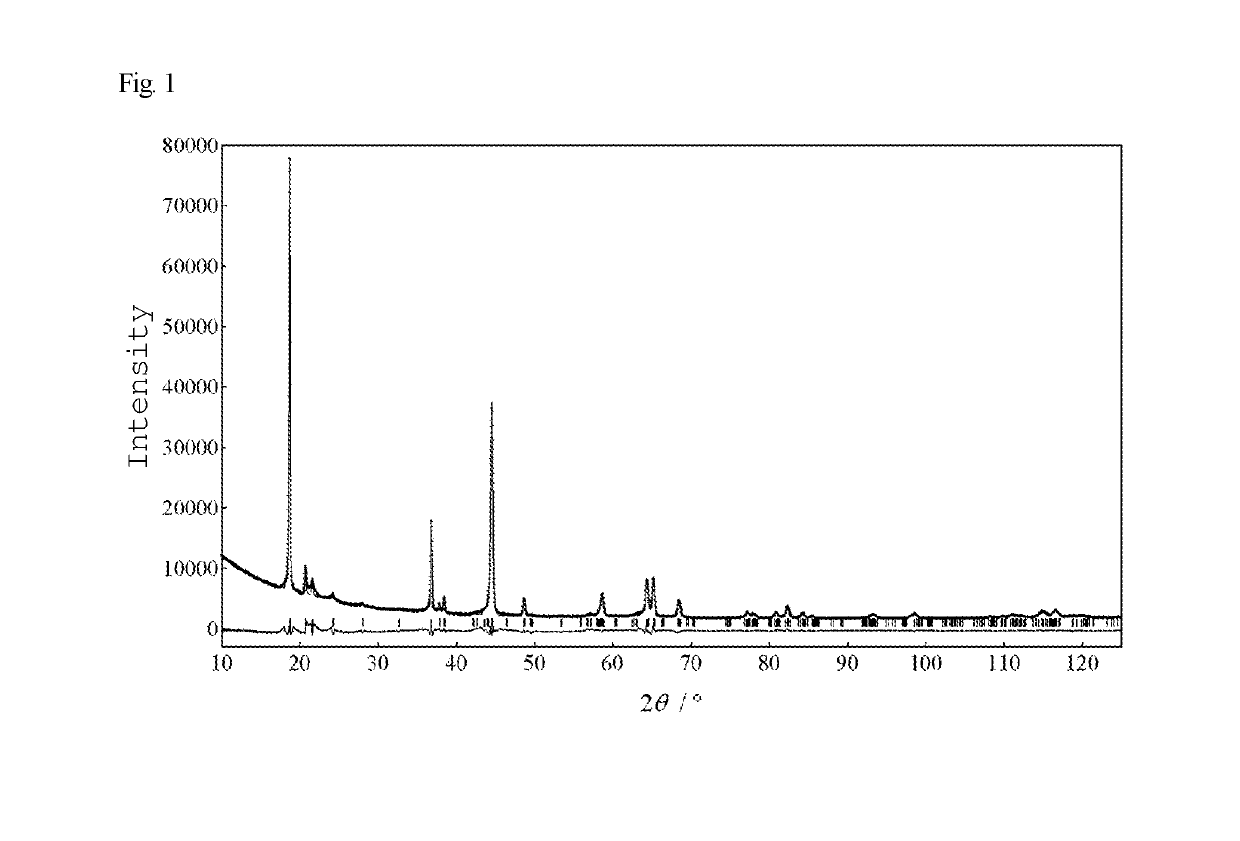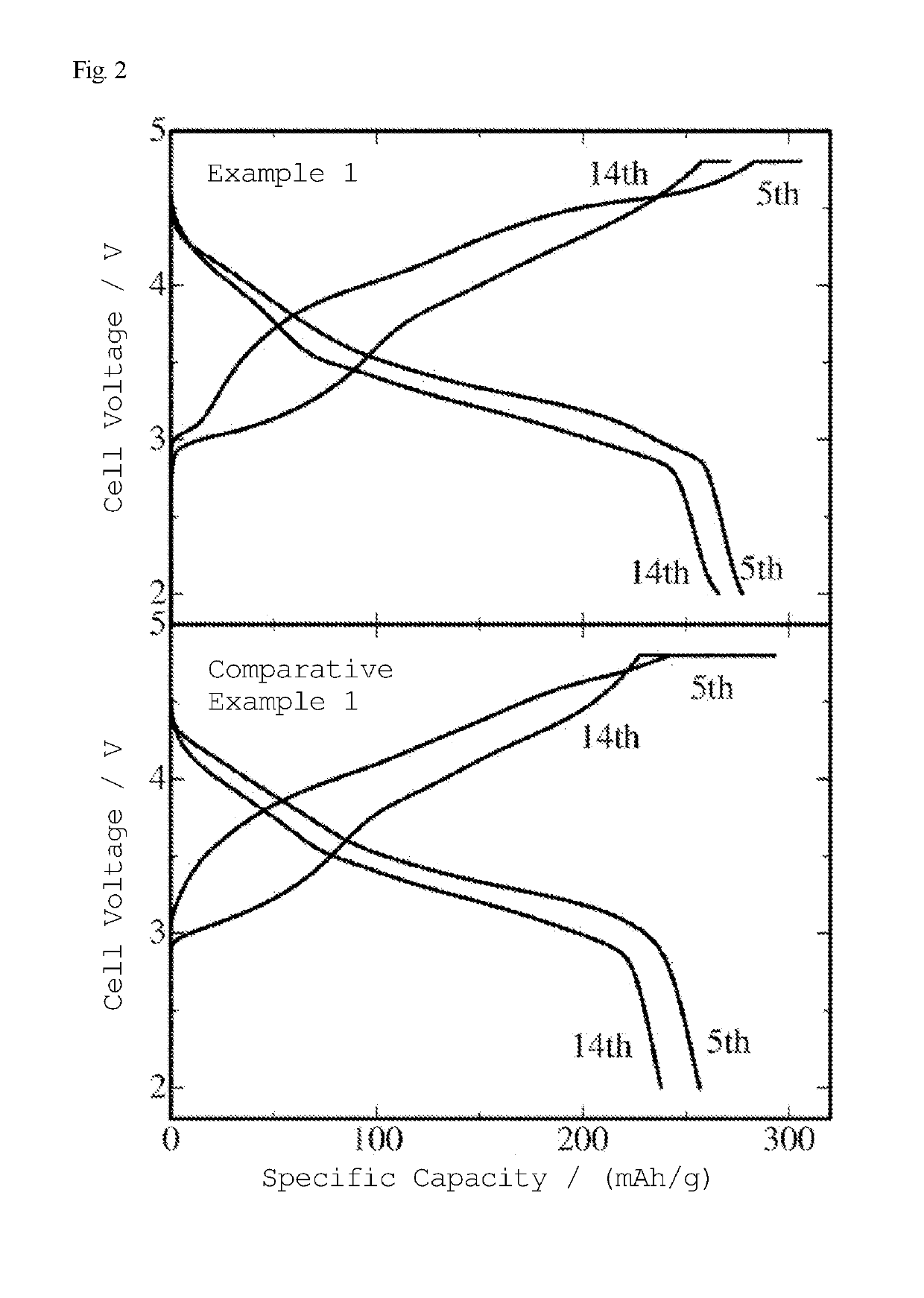Lithium-manganese complex oxide and method for producing same
- Summary
- Abstract
- Description
- Claims
- Application Information
AI Technical Summary
Benefits of technology
Problems solved by technology
Method used
Image
Examples
example 1
Synthesis of Specimen, and Evaluation of Structure and Composition
[0106]10.10 g of iron(III) nitrate nonahydrate, 7.27 g of nickel(II) nitrate hexahydrate, and 39.58 g of manganese(II) chloride tetrahydrate (total amount: 0.25 mol, Fe:Ni:Mn molar ratio 1:1:8) were added to 500 mL of distilled water and fully dissolved, thereby obtaining a metal salt aqueous solution. 50 g of sodium hydroxide was weighed in another beaker, and 500 mL of distilled water was added thereto to dissolve sodium hydroxide with stirring, thereby preparing a sodium hydroxide aqueous solution. This sodium hydroxide aqueous solution was placed in a titanium beaker, and allowed to stand in a thermostatic bath maintained at +20° C. Subsequently, the metal salt aqueous solution was gradually added dropwise to this sodium hydroxide solution over about 3 hours, thereby forming an Fe—Ni—Mn precipitate (coprecipitate). After the reaction mixture was confirmed to have completely become alkaline, oxygen was blown into t...
example 2
[0112]A specimen was prepared in the same manner as in Example 1, except that the calcination temperature was set at 400° C. during carbon reduction (after lithium acetate was added). FIG. 3 illustrates an actually measured X-ray diffraction pattern (+) and a calculated X-ray diffraction pattern (solid line) of this final product. The results of analysis by the RIETAN-FP program for Rietveld analysis indicate that all peaks can be indexed with the lattice constants shown in Table 1 below, and that the final product was composed only of a crystalline phase having a unit cell (C2 / m) of monoclinic crystal Li2MnO3 (layered rock-salt crystalline phase). The distribution of transition metal ions in the structure shown in Table 2 indicates that the specimen of Example 2 had a higher total transition metal content per compositional formula than the specimen of Comparative Example 1, which was of the same original transition metal composition, and which was not subjected to carbon reduction ...
example 3
[0118]15.15 g of iron(III) nitrate nonahydrate, 10.90 g of nickel(II) nitrate hexahydrate, and 34.63 g of manganese(II) chloride tetrahydrate (total amount: 0.25 mol, Fe:Ni:Mn molar ratio 15:15:70) were added to 500 mL of distilled water and fully dissolved, thereby preparing a metal salt aqueous solution. A specimen was prepared in the same manner as in Example 1, except that this metal salt aqueous solution was used. FIG. 6 illustrates an actually measured X-ray diffraction pattern and (+) and a calculated X-ray diffraction pattern (solid line) of this final product The results of analysis by the RIETAN-FP program for Rietveld analysis indicate that all peaks were indexed with the lattice constants shown in Table 1 below, and the final product was composed only of a crystalline phase having a unit cell (C2 / m) of monoclinic crystal Li2MnO3 (layered rock-salt crystalline phase). The distribution of transition metal ions in the structure shown in Table 2 indicates that the specimen o...
PUM
 Login to View More
Login to View More Abstract
Description
Claims
Application Information
 Login to View More
Login to View More - Generate Ideas
- Intellectual Property
- Life Sciences
- Materials
- Tech Scout
- Unparalleled Data Quality
- Higher Quality Content
- 60% Fewer Hallucinations
Browse by: Latest US Patents, China's latest patents, Technical Efficacy Thesaurus, Application Domain, Technology Topic, Popular Technical Reports.
© 2025 PatSnap. All rights reserved.Legal|Privacy policy|Modern Slavery Act Transparency Statement|Sitemap|About US| Contact US: help@patsnap.com



